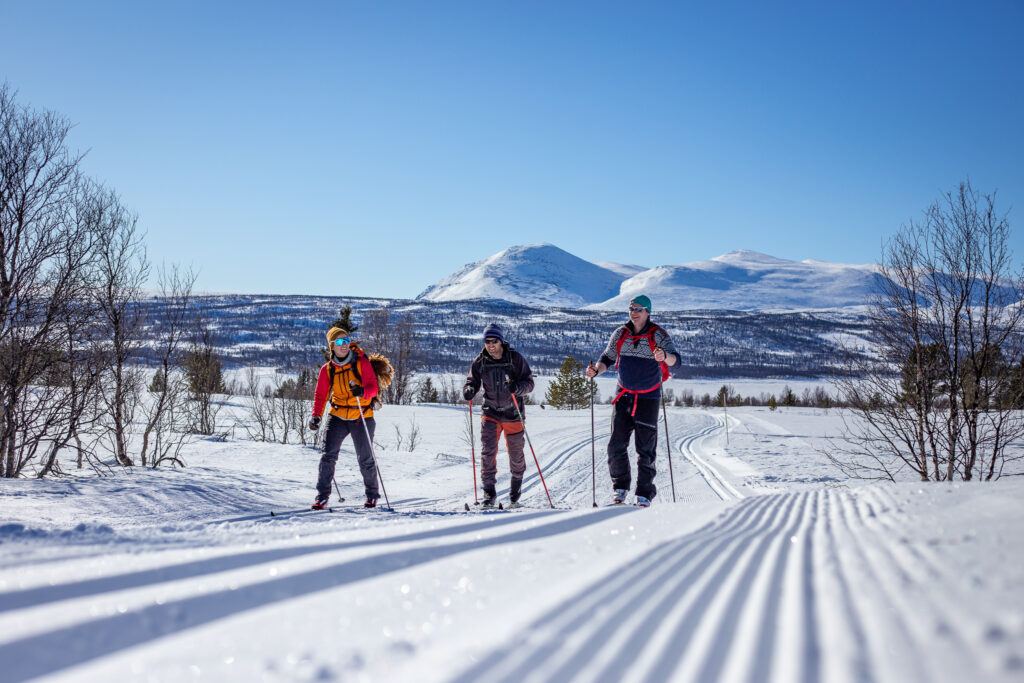Crisp air, sunny Norwegian winter wonderland and freshly groomed tracks in the mountains around you – the perfect day for cross-country skiing is about to start for you soon. When coming over to Norway to have a good time on skis, one of the most common questions is, how to dress right for being active outside during winter.
Layering is the Base
No matter if you are a pro or a beginner in cross-country skiing, dressing right is one of the main things to consider for having a great time. But it’s neither rocket science nor a big deal when you follow some basic advice.
For cross-country skiing you can expect a range of temperatures from around 0C to -20C here in the Valdres and Jotunheimen area. In addition, wind chill can make these temperatures feel much colder. So how to prepare for this?
In general, it is of course a difference if you really want to go all in for a proper hard training session or more like strolling around through spectacular landscapes (which is what most people are doing).
Sporty skiers often start with more clothing and peel them off after a while, people that take it more relaxed should consider wearing an extra layer for not cooling down too quick.

The base of every good experience outdoors, no matter if in summer, autumn or winter, is layering your clothing, so you can adjust your different layers according to the predominant weather conditions – just like you do it with waxing your skis.
Here is what the most common layering when it comes to upper body clothing in outdoors looks like:
The Baselayer
For cross-country skiing or any other outdoor activity we recommend woollen underwear made from merino wool. The advantage of these clothes is the material that gives you warmth even when it’s getting a little wet from e.g. sweating. Merino wool is also known for its ability to not stink even if you wear it a couple of days in a row.
The Midlayer
This layer gives you extra warmth but will also remove the sweat from the first layer and transfer this to the outer layer so that you will stay warm and dry during activity. Most of the time, this layer is made of a wool/synthetic fibers and can be a longsleeve, a light insulation jacket or a fleece pullover. When choosing a piece of clothing for this layer we recommend always one with a long neck so that your neck is always well protected from the cold and wind.
The Outer Layer
The outer layer is protection from wind and rain. Honestly it is winter, so rain is not such a big deal, but wet snow can be one. So a waterproof or at least water repellent jacket made of shell material is always a good choice. A lightweight hardshell jacket with pit zips can also be the piece to wear, especially if you want to use clothing you maybe already have from hiking or biking. Always remember that cross-country skiing can be sweaty if your pulse is rising, so a good ventilation option is definitely a big pro!
The Extra for More Warmth
When temperatures are dropping to especially coldness you can add maybe a softshell jacket in addition or an extra layer under your usual jacket. If there is no wind, a thick woollen sweater can also be a good choice. Same with your legs, and extra layer under your usual pants like thin tights can help a lot.




Tights or Pants
For high-intensity workouts or mild weather, wear cross-country ski tights or winter running tights.
For low-intensity activities or colder conditions, partially insulated cross-country ski pants are a better option.
On easy-going track days or Nordic backcountry skiing, softshell-style cross-country ski pants provide the best comfort and protection.
Protect your Head – Wear a Headband or a Thin Beanie
On sunny days or during intense workouts, opt for a simple, lightweight headband.
If you need extra warmth, a light beanie is a good choice. A thick wool beanie is not necessary as it’ll be too warm soon when you exercise.
For added protection against the cold, some skiers also like to wear a thin neck gaiter.
Gloves or Mittens
Thin gloves are ideal for high-intensity workouts or warm weather. Running gloves can also work.
For colder conditions or less intense activity, thicker gloves provide better insulation.
In winter conditions or if you’re prone to cold hands, mittens or 3-finger mitts offer superior warmth.

Warm Socks or Thin Socks
Thin, mid-calf cross-country ski socks are the most popular and comfortable choice. Avoid knee-length alpine ski socks as they tend to be too warm.
If your feet get cold, try wearing wider boots or loosening your laces to improve blood circulation — even if it means sacrificing a bit of ski control.
Carrying your Essentials
A cross-country ski belt is the best way to carry water, snacks, and personal items. Worn on your back, it keeps items warm and protected from wind and cold.
Lightweight daypacks can also be a good choice, especially when you want to go on longer trips and e.g. you want to bring a Termos with you or an insulation seat pack for your breaks. But a backpack might restrict arm movement a little bit if you are a sporty one and could become uncomfortable.
Are you ready now for you next cross-country trip?
Now you are prepared for you next cross-country or snowshoeing trip! Always keep in mind not to overdress for activities like cross-country skiing or snowshoeing, even if you feel chilly at the start. The advantage of being active and sporty outdoors – you’ll warm up as you go soon!



